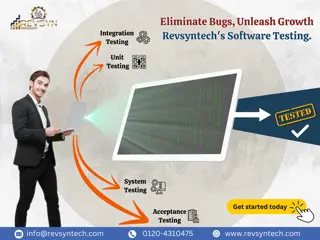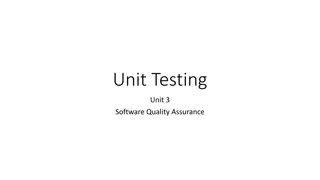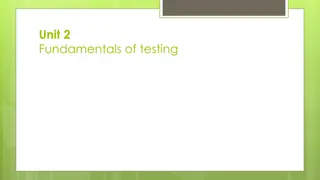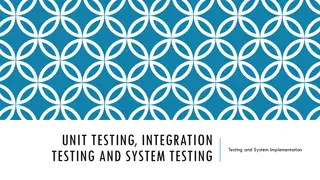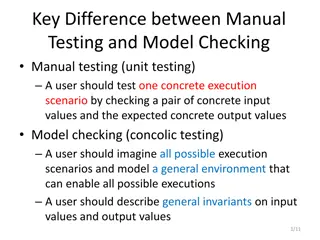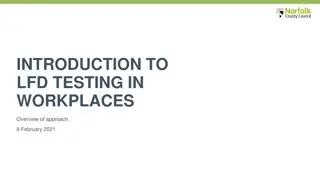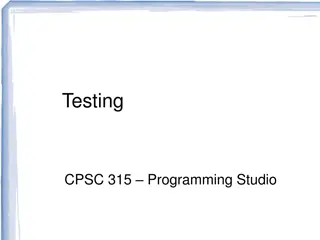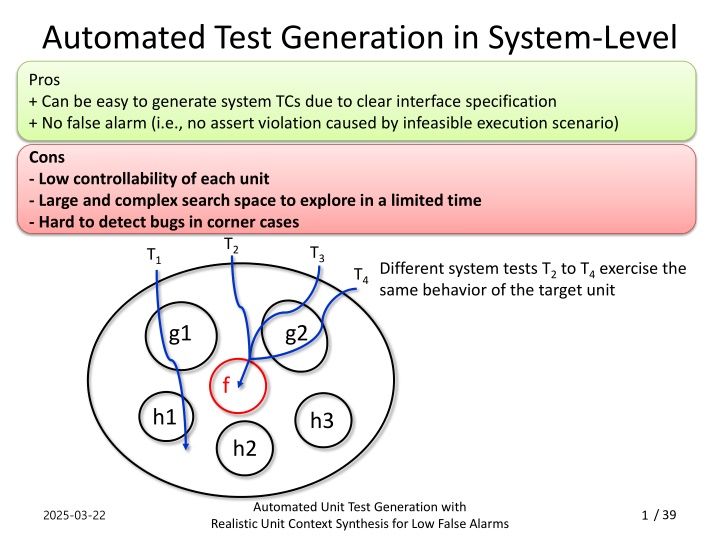
Automated Test Generation: Pros and Cons Discussed with Realistic Context Synthesis
Explore the benefits and drawbacks of automated test generation at system and unit levels, along with the importance of realistic unit context synthesis. Discover how these methods help in detecting bugs effectively while minimizing false alarms.
Download Presentation

Please find below an Image/Link to download the presentation.
The content on the website is provided AS IS for your information and personal use only. It may not be sold, licensed, or shared on other websites without obtaining consent from the author. If you encounter any issues during the download, it is possible that the publisher has removed the file from their server.
You are allowed to download the files provided on this website for personal or commercial use, subject to the condition that they are used lawfully. All files are the property of their respective owners.
The content on the website is provided AS IS for your information and personal use only. It may not be sold, licensed, or shared on other websites without obtaining consent from the author.
E N D
Presentation Transcript
Automated Test Generation in System-Level Pros + Can be easy to generate system TCs due to clear interface specification + No false alarm (i.e., no assert violation caused by infeasible execution scenario) Cons - Low controllability of each unit - Large and complex search space to explore in a limited time - Hard to detect bugs in corner cases T2 T3 T1 Different system tests T2 to T4 exercise the same behavior of the target unit T4 g2 g1 f h1 h3 h2 Automated Unit Test Generation with Realistic Unit Context Synthesis for Low False Alarms 2025-03-22 / 39 1
Automated Test Generation in Unit-Level Pros + High controllability of a target unit + Smaller search space to explore than system testing + High effectiveness for detecting corner cases bugs Cons - Hard to write down accurate unit test drivers/stubs due to unclear unit specification - High false/true alarm ratio Different unit tests Tu1 to Tu3 directly exercise different behaviors of the target unit, but Tu2 to Tu3 exercise infeasible paths g1 g2 Tu1 Tu2Tu3 Legend A feasible execution An infeasible execution f h1 h3 h2 Automated Unit Test Generation with Realistic Unit Context Synthesis for Low False Alarms 2025-03-22 / 39 2
Automated Unit Test Generation with Realistic Unit Context Pros + High controllability of a target unit + High effectiveness for detecting corner cases bugs + Low false alarm ratio Unit tests Tu4 that exercises an infeasible path is filtered out by the unit context Realistic unit context filters out unit tests that exercise infeasible paths various behaviors of f Tu4 Different unit contexts explore Tu5 Tu6 g1 g1 g2 g2 Legend A feasible execution An infeasible execution f h1 h3 h3 h2 h2 Automated Unit Test Generation with Realistic Unit Context Synthesis for Low False Alarms 2025-03-22 / 39 3
Related Work on Automated Unit Testing False/True alarm ratio Target languages Bug detection ability Procedural or OO languages Function input generation [PLDI 05][FSE 05][EMSOFT 06][TAP 08][ISSTA 08][SEC 15] High High Object- oriented languages Method-sequence generation [ICSE 07] [ICST 10][FSE 11] [ICSE 13] High Medium Object- oriented languages Capture system tests to generate unit tests [TSE 09] [STTT 09][ISSTA 10] Low Low High Low Automated Unit Test Generation with Realistic Unit Context Procedural languages (86.7% of target bugs in SIR and SPEC2006) (2.4 false alarms per one true alarm) Automated Unit Test Generation with Realistic Unit Context Synthesis for Low False Alarms 2025-03-22 / 39 4
Approximate Input Space for Symbolic Unit Testing Over-approximated symbolic inputs User-specified symbolic inputs Real inputs to target unit Possible false negative Infeasible input of false alarm Under-approximate symbolic inputs 3/22/2025 / 39 5
Unit-testing Busybox ls We performed unit-testing Busybox ls by using CREST We tested 14 functions of Busybox ls (1100 lines long) Note that this is a refined testing activity compared to the previous testing activity for 10 Busybox utilities in a system-level testing 6 /35 3/22/2025
Busybox ls Requirement Specification POSIX specification (IEEE Std 1003.1, 2004 ed.) is a good requirement specification document for ls A4 ~10 page description for all options We defined test oracles using assert statements based on the POSIX specification Automated oracle approach However, it still required human expertise on Busybox ls code to define concrete assert statements from given high-level requirements 7 /35 3/22/2025
8 /35 3/22/2025
Four Bugs Detected Missing @ symbol for a symbolic link file with F option Missing space between adjacent two columns with i or b options The order of options is ignored According to the ls specification, the last option should have a higher priority (i.e., -C -1 and -1 -C are different) Option n does not show files in a long format -n enforces to list files in a long format and print numeric UID and GID instead of user/group name 1. 2. 3. 4. 9 /35 3/22/2025
Missing @ symbol for symbolic link with F option Busybox ls does not print a type marker @ after a symbolic link file name, when -F is specified and a file name is specified in the command line. Output of linux ls: 1. $ ls -F t.lnk t.lnk@ Output of Busybox ls (incorrect behavior): 2. $ ./busybox ls -F t.lnk t.lnk -F means write a marker (/*|@=) for different type of files. t.lnk is a symbolic link, which links to file t in the directory ~yang/ We found that the bug was due to the violation of a precondition of my_stat() /35 10 3/22/2025
Calls Graph of Busybox ls buggy behavior Replaced by unit-stat() and unit-lstat() for unit-testing unit-stat unit-lstat Replaced by unit- unit-stat unit-lstat stat() and unit-lstat() for unit-testing correct behavior /35 11
ls_main int ls_main(int argc UNUSED_PARAM, char **argv) Purpose: ls_main obtains specified options and file/dir names from command line input. Calculate runtime features by specified options. unsigned int optis defined to represent all options given in the command line arguments opt = getopt32(argv, ls_options, &tabstops, &terminal_width) unsigned int all_fmtis defined to represent all runtime features based on the given command line options and compile time option opt_flags[] all_fmt=fun (opt, opt_flags) Print file/dir entries of a file system whose names and corresponding options are given in the command line input by calling sub-functions 1. 2. 1) 2) 3. /35 12
my_stat static struct dnode *my_stat(const char *fullname, const char *name, int force_follow) Purpose: my_stat gets file status by fullname, and store file status in struct dnode *cur which is returned by my_stat If a file/dir entry corresponding to fullname is available in the file system, cur->stat should stores the corresponding file info. Otherwise, NULL is turned. Pre condition: len (fullname) >= len(name) If any of -d, -F, or -l options is given, and -L option is not given, follow_symlink should be false ((-d || -F || -l) && !-L) -> !follow_symlink 1. 2. 1. 2. -d: llist directory entries instead of contents, and do not dereference symbolic links -F: append indicator (one of */=>@|) to entries -l: use a long listing format -L: when showing file information for a symbolic link, show information for the file the link references rather than for the link itself t.lnk t (stat_t_lnk) (stat_t) /35 13
my_stat static struct dnode *my_stat(const char *fullname, const char *name, int force_follow) Post condition: When fullname is a real file name, the following condition should be satisfied: (cur!=NULL && cur->fullname==fullname && cur->name==name) 1. struct stat { dev_t st_dev; /* ID of device containing file */ ino_t st_ino; /* inode number */ mode_t st_mode; /* protection */ nlink_t st_nlink; /* number of hard links */ uid_t st_uid; /* user ID of owner */ gid_t st_gid; /* group ID of owner */ dev_t st_rdev; /* device ID (if special file) */ off_t st_size; /* total size, in bytes */ blksize_t st_blksize; /* blocksize for filesystem I/O */ blkcnt_t st_blocks; /* number of blocks allocated */ time_t st_atime; /* time of last access */ time_t st_mtime; /* time of last modification */ time_t st_ctime; /* time of last status change */}; struct dnode { const char *name; const char *fullname; /* point at the next node */ struct dnode *next; smallint fname_allocated; /* the file stat info */ struct stat dstat; } /35 14
Assertions in my_stat 1. static struct dnode *my_stat(const char *fullname, const char *name, int force_follow) 2. { 3. #ifdef ASSERTION 4. assert(strlen(fullname) >= strlen(name)); 5. #endif 6. struct stat dstat; 7. struct dnode *cur; 8. IF_SELINUX(security_context_t sid = NULL;) 9. #ifdef ASSERTION 10./* If any of -d, -F, or -l options is given, and -L 11. * option is not given, ls should print out the status 12. * of the symbolic link file. I.e., 13. * ((d || F || l) && !L) -> !FOLLOW_SYM_LNK 14. */ 15.unsigned char follow_symlink = 16. (all_fmt & FOLLOW_LINKS) || force_follow; 17.assert(!((opt_mask[2] || opt_mask[17] || opt_mask[4]) 18. && !opt_mask[19]) || !follow_symlink); 19.#endif 20. if (follow_symlink) { /*get file stat of link itself*/ 21. // 22.#if !CREST 23. if (stat(fullname, &dstat)) 24.#else 25. if (unit_stat(fullname, &dstat)) 26.#endif 27. { 28. bb_simple_perror_msg(fullname); 29. exit_code = EXIT_FAILURE; 30. return 0; 31. } 32. } else { /*get file stat of real file which sym_lnk linked to*/ 33. // 34.#if !CREST 35. if (lstat(fullname, &dstat)) 36.#else 37. if (unit_lstat(fullname, &dstat)) 38.#endif 39. { 40. bb_simple_perror_msg(fullname); 41. exit_code = EXIT_FAILURE; 42. return 0; 43. } 44. } 44. cur = xmalloc(sizeof(*cur)); 45. cur->fullname = fullname; 46. cur->name = name; 47. cur->dstat = dstat; 48. IF_SELINUX(cur->sid = sid;) 49.#ifdef ASSERTION 50.assert(strcmp(fullname, cur->fullname)==0); 51.assert(strcmp(name, cur->name)==0); 52.#endif 53. return cur; 54. } /35 15
Symbolic Environment Setting Symbolic variables: Command line options Target file status we partially simulate status of a file (struct stat dstat) in a file system by a symbolic value Test stubs: stat() and lstat() are replaced by unit-stat() and unit-lstat() for generating symbolic file status stat(const char *path, struct stat *buf) lstat(const char *path, struct stat *buf) /35 16
Symbolic Variables Symbolic options Replacing unsigned int opt with a symbolic value. opt = getopt32(argv, ); unsigned char opt_mask[22] is defined to replace opt each element in opt_mask[] specifies a symbolic value for each bit of opt Symbolic file status Replacing mode_t dstat.st_mode with a symbolic value st_mode stores information on a file type, file permission, etc. in each bit. sizeof(st_mode)=sizeof(unsigned int) /35
Stub Function unit-stat(), unit-lstat() Struct stat { mode_t st_mode } stat() File System file1 Struct stat { mode_t st_mode } lstat() Struct stat { mode_t st_mode //symbolic value } unit- stat() File System Struct stat { mode_t st_mode //symbolic value } unit- lstat() 18 /35 3/22/2025
Test Driver for Symbolic Command Line Options 50.int ls_main(int argc UNUSED_PARAM, char **argv) 51.{ 52.// 53./* process options */ 54. IF_FEATURE_LS_COLOR(applet_long_options 55. = ls_longopts;) 56.#if ENABLE_FEATURE_AUTOWIDTH 57. opt_complementary="T+:w+"; /* -T N, -w N */ 58. opt = getopt32(argv, ls_options, &tabstops, 59. & terminal_width, IF_FEATURE_LS_COLOR 60. (&color_opt)); 61.#else 62. opt = getopt32(argv, ls_options 63. IF_FEATURE_LS_COLOR(&color_opt)); 64.#endif 65. 66.//START of calculating all_fmt value 67. for (i = 0; opt_flags[i] != (1U<<31); i++) { 68. if (opt & (1 << i)) 69. { 70. unsigned flags = opt_flags[i]; 71. //refresh value when trigger is on 72. if (flags & LIST_MASK_TRIGGER) //0 73. all_fmt &= ~LIST_MASK; 74.// 75. all_fmt |= flags; 76. } 77. } 78.//processing all_fmt for some special cases 79. if (argv[1]) 80. all_fmt |= DISP_DIRNAME; /* 2 or more items? label directories */ 81.//END of calculating all_fmt value 82.//calling internal functions 83.} /35 19
Test Driver for Symbolic File Status 1. #define OPTSIZE 22 2. #define MODESIZE 32 3. unsigned char opt_mask[OPTSIZE]; 4. unsigned char modemask[2][MODESIZE]; 5. static char file_no=0; 6. 7. #define SYM_S_ISLNK(mode) ((mode)[12]==0 && (mode)[13]==1 && (mode)[14]==0 && (mode)[15]==1) 27. buf->st_mode = bstoi(local_mode, MODESIZE); 28. } 29. file_no++; 30. return 0; 31. }else 32. return -1; 33.} 34. 35.static int unit_lstat(const char *path, struct stat *buf){ 36. unsigned char local_mode[32]; 37. char ret; 38. CREST_char(ret); 39. if(ret==(char)0){ 40. if(gen_sym_file_stat(buf)){ 41. memcpy(local_mode, modemask[file_no], MODESIZE); 42. buf->st_mode = bstoi(local_mode, MODESIZE); 43. } 44. file_no++; 45. return 0; 46. }else 47. return -1; 48.} 8. //simulating file status by symbolic value 9. static char gen_sym_file_stat(struct stat *buf){ 10. int i; 11. for(i=0 ; i<MODESIZE ; i++){ //file type 12. CREST_unsigned_char(modemask[file_no][i]); 13. } 14. return 1; 15.} 16. 17.static int unit_stat(const char *path, struct stat *buf){ 18. unsigned char local_mode[32]; 19. char ret; 20. CREST_char(ret); 21. if(ret==(char)0){ 22. if(gen_sym_file_stat(buf)){ 23. memcpy(local_mode, modemask[file_no], 32); 24. if(SYM_S_ISLNK(local_mode)){ //link 25. local_mode[13]=0; //change to reg file 26. } /35 20

